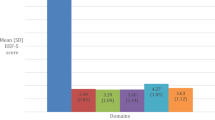Abstract
We tried to compare the parameters of nocturnal penile tumescence and rigidity (NPTR) testing with erectile function (EF) domain score of International Index of Erectile Function (IIEF), which is used in diagnosis and determining the severity of erectile dysfunction (ED), and to assess the sufficiency of IIEF in the diagnosis of ED. A total of 90 men, mean age 46 years (24–75), presenting with ED to our clinic between January 2001 and March 2003 were included in the trial. All the men answered the standard IIEF (15 questions) forms and was divided into four groups as mild ED, moderate ED, severe ED and no ED according to the EF domain score that is obtained from 1st, 2nd, 3rd, 4th, 5th and 15th questions. Then NPTR testing with the RigiScan Plus monitoring device was performed for two consecutive nights on those men. The distribution of the six parameters of NPTR testing (number of erections, duration of erections, TAU base, RAU base, TAU tip, RAU tip) among the four groups and the correlation with IIEF-EF domain score were evaluated. Additionally, the distribution of the risk factors (diabetes mellitus, hypertension, atherosclerotic heart disease, dyslipidemia and smoking) was analyzed both among the four groups and in each group. According to IIEF-EF domain scores of 90 patients, 16 (18%) had severe ED, 21 (23%) moderate ED, 41 (46%) mild ED and 12 (13%) no ED. There was no statistically significant difference between the risk factors among the men in these groups (P>0.05). When the IIEF-EF domain scores were compared with parameters of NPTR testing, no statistically significant difference was obtained among ED groups (mild, moderate, severe) (P>0.05). However, we observed a statistically significant difference between three ED groups and no ED group (P<0.05). If NPTR testing is considered as a gold standard test, sensitivity, specificity, positive predictive value and negative predictive value of IIEF-EF domain score in ED diagnosis are 100, 17.9, 29.4 and 100% respectively. In conclusion, we did not observe a clinical correlation between IIEF-EF domain scores and NPTR parameters in the whole population; however, we observed that if IIEF-EF domain scores were normal, NPTR parameters were also normal. In other words, we can say that if the initial IIEF-EF domain scores are normal, then we do not have to perform NPTR testing. This could be helpful to make a cost-effective diagnosis.
This is a preview of subscription content, access via your institution
Access options
Subscribe to this journal
Receive 8 print issues and online access
$259.00 per year
only $32.38 per issue
Buy this article
- Purchase on Springer Link
- Instant access to full article PDF
Prices may be subject to local taxes which are calculated during checkout
Similar content being viewed by others
References
Bain CL, Guay AT . Classification of sexual dysfunction for management of intracavernous medication-induced erections. Letter to the editor. J Urol 1991; 146: 1379.
Lue TF . Editorial comment. J Urol 1986; 135: 282.
NIH Consensus Development Panel on Impotence. Impotence. JAMA 1993; 270: 83–90.
Hawton K . Sex Therapy: A Practical Guide. New York: Oxford University Press, 1985, p 36.
McKinlay JB . The worldwide prevalence and epidemiology of erectile dysfunction. Int J Impot Res 2000; 12: S6.
Rosen R, Riley A, Wagner G, Osteroh I, Kirkpatrick J, Mishra A . The international index of erectile function (IIEF): a multidimensional scale for assessment of erectile dysfunction. Urology 1997; 49: 822–830.
Karacan I, Goodenough DR, Shapiro A, Starker S . Erection cycle during sleep in relation to dream anxiety. Arch Gen Psychiatr 1966; 15: 183.
Fisher C, Gross J, Zuch J . Cycle of penile erection synchronous with dreaming (REM) sleep: preliminary report. Arch Gen Psychiatr 1965; 12: 29–45.
Bain CL, Guay AT . Reproducibility in monitoring nocturnal penile tumescence and rigidity. J Urol 1992; 148: 811–814.
Kassouf W, Carrier S . A comparison of the international index of erectile function and erectile dysfunction studies. BJU Int 2003; 91: 667–669.
Author information
Authors and Affiliations
Corresponding author
Rights and permissions
About this article
Cite this article
Tokatli, Z., Akand, M., Yaman, O. et al. Comparison of international index of erectile function with nocturnal penile tumescence and rigidity testing in evaluation of erectile dysfunction. Int J Impot Res 18, 186–189 (2006). https://doi.org/10.1038/sj.ijir.3901390
Received:
Revised:
Accepted:
Published:
Issue Date:
DOI: https://doi.org/10.1038/sj.ijir.3901390
Keywords
This article is cited by
-
Effect of internet pornography use frequency on psychogenic erectile dysfunction severity in young Turkish men: the mediating role of dyadic adjustment
International Journal of Impotence Research (2023)
-
Erectile Dysfunction and Sexual Hormone Levels in Men With Obstructive Sleep Apnea: Efficacy of Continuous Positive Airway Pressure
Archives of Sexual Behavior (2016)
-
Question for a questionnaire: the International Index of Erectile Function
International Journal of Impotence Research (2011)
-
Relationship between chronic tadalafil administration and improvement of endothelial function in men with erectile dysfunction: a pilot study
International Journal of Impotence Research (2007)


